A record group of 25 skis, a kayak, and an OC-1 converged on Fisherman’s Beach in Swampscott for the Nahant Bay Cup this past Saturday. Race Director Mike McDonough greeted us warmly as we trickled in on the cool, overcast morning. The ocean conditions were mild, to say the least. The slight westerly breeze barely rippled the water. We’d be running the same course as the previous year – starting at the end of a nearby dock, cutting diagonally across Nahant Bay, rounding East Point to a turn-around buoy, heading back across the mouth of the bay, before turning around Off Rock and making our way back around the rocky coast to a beach finish. Mike had thoughtfully prepared some laminated photos and maps of the course, which he carefully reviewed with each racer beforehand (cue the video montage of paddlers missing turns, heading over the horizon, and crashing into things).
During the captain’s meeting, a light rain peppered down as Mike described the course and went over the ground rules. Apparently, biting would no longer be tolerated. Kirk Olsen helpfully suggested that we use a Lemans-style beach start to ease congestion at the starting line – a familiar practice to those of us who regularly race in the Salem Sound League. Mike’s eyes seemed to glaze over for a moment as he considered this attractive option, but he ultimately resisted the urge to give the North Shore folk a leg up on the competition.
Shortly after, we were on the water, warming up among the moored pleasure boats, then jockeying for position at the starting line. As expected, Borys Markin, Eric McNett, and Onno Bokhove (a speedster visiting from the Netherlands) went out fast, joined by Junior Prates, who is quickly recovering his skills after hanging up his paddle several years ago due to shoulder problems. Those four quickly separated from the pack, with Onno heading out to sea in an apparent attempt to verify that dubious “earth is round” hypothesis.
Tim Dwyer and I had talked briefly before the race about working together for the common good should we find ourselves close in the race. As fate would have it, we soon found ourselves in that position. A mile into the race, Tim, Graeme Rockett, Wesley Echols and myself were in a small group chasing Francisco (who in turn was chasing the lead pack). I had followed Graeme out from the start and was now tucked in behind Wesley. I decided to push the pace and started to pull around Wesley. Like the battle-hardened sergeant in a war movie, Tim took charge of his platoon. He barked out his attack plan: “Diamond formation! Lesher’s got the point. Echols, get on his six. Rockett, you’ll be guarding the left flank. I’ll take out the sniper nest, er…, I mean, I’ll cover the other flank.” Energized by the knowledge that I had a support team at my back, I tore after Francisco. I knew that if I were to fall, my comrades would pull me to safety.
After a few minutes of this, I found myself wondering when exactly my support team would be relieving me. Fortunately, after another minute or so I managed to close the gap with Francisco, latching onto his wash. When I looked back to see what had happened to our stalwart band, I found Tim alone had managed to pull through. Graeme and Wesley had been lost at sea. There was nothing we could do. The saying is “never leave a man behind”. Two men, I reckon that’s a different story. They would have wanted us to paddle on.
Behind us, various pods were forming as the paddlers clumped into support groups to mutually push each other. Up at the front, Borys had managed to open a significant gap on the rest of the lead pack. Apparently reminiscing about his happy wanderings in the Triple Beaver a few weeks ago, he rounded the wrong buoy and started back across Nahant Bay. After a few hundred feet, he encountered the chase pack, who graciously (or, perhaps, grudgingly) pointed out his error. He doubled back and quickly retook his lead.
Francisco, Tim, and I rounded the buoy with Junior in our sights. After an impressive run with the immortals, it seemed like he might be flagging. As a justifiably nervous paddler (I’m pretty sure I hold the New England record for most races with capsizes), I’d up until recently avoided using the V12 footstraps. I wanted to be able to escape quickly in the event of a nautical emergency, and the footstraps felt a little too much like tying myself to the mast. I relented last week and was happy to find that I hadn’t yet drowned. I was also pleasantly surprised to discover that the footstraps make sharp corners much easier to navigate, as I could now edge the ski around the turns. I was able to keep on Tim’s wash through the turn (a problem area for me in the past), and we three quickly reestablished our tripod. As we passed Junior, he latched on for a while, but decided soon after to go it alone on an inside line, tetrapod be damned.
As we continued across Nahant Bay, Francisco set a blistering pace for Tim and I, who were valiantly hanging on his wash. For a mile or so, I had gotten the benefit of riding in the back of a partial diamond configuration when Tim was riding Francisco’s side wash. We had since settled into a straight train, but I wondered if perhaps I oughtn’t to be a good citizen and try to return the favor. Getting ahead of Francisco seemed unlikely at this stage, but perhaps Tim and I could help one another conserve enough energy to pass him later on. That also seemed pretty unlikely, but you can’t make an omelet without breaking a few eggs. Or something like that. I made a couple of half-hearted attempts to break around Tim, but each time I proved unworthy to the task and slipped back to safety behind him.
After a while, I noticed that Tim doing something peculiar. In lieu of a stroke, he lightly slapped his paddle down on the left. Was this some kind of coded message to me? Did he want me to come up into the 2nd position in the train so he could benefit from the easier ride in the 3rd position? There it was again! I didn’t recall anything about this in the Handbook of Drafting Etiquette (4th Edition). I wavered. And then, a quick double-slap from Tim. There could be no doubt. To hell with the HDE (4E)… I was being called into action! With echoes of a bugle charge resounding in my head, I broke out of the wash into undisturbed water.
I knew immediately that I had made a terrible mistake. Out of the slipstream at that tremendous speed, everything happened in accelerated motion. Like a dog sticking its head out of a fast-moving car, my eyes teared up, spittle was flying everywhere, and my ears were flapping behind me. I put my head down and went into hummingbird mode, paddle flailing the water in a desperate attempt to pull ahead of Tim. I wasn’t carrying my body weight in nectar with me, so it was evident that I couldn’t maintain the pace very long. Tail between my legs, I used the last of my turbo boost to latch back on the train.
After the race, Tim swore that his unmistakable paddle-slap signals were, in fact, micro-braces. In retrospect, that does make some sense. But what about those head bobs? Now those *must* have been coded messages…
There’s been a lot of unkind criticism about Francisco’s line across the Bay. While it’s true that his GPS track reveals a path with rather more curve than you’d expect from a straight line, the proof, as they say, is in the putting (of all the naysayers in their proper place – below Francisco in the results). That didn’t stop Tim and I from offering some helpful navigational tips from our comfortable wash positions, however. It takes a fair amount of chutzpah for the remoras to guide the shark, but since were kibitzing anyway, I couldn’t help yelling out some other advice – “Your left hand is dropping too low!”, “Your 401(k) is dangerously undiversified!”, and “You should get that splotch on your gill checked out!” He doesn’t like to show it, but I’m pretty sure Francisco appreciates our heart-felt expressions of concern for his well-being.
Once we rounded Off Rock, our small group broke up. Each in his own private hell (mine had mimes), we pushed ourselves for the final mile. Weaving in amongst the rocks of Dread Ledge to cut the shortest line, my face was frozen in an expectant wince-grimace as I watched the bottom slide by, rudder-crunchingly close. After we had cleared the danger, I concentrated mightily on maintaining proper form. Keep the hands high. Make a solid plant. Drive with the legs. Tuck those ears in. I felt pretty good about my execution on those elements, but in the effort forgot to steer. I found myself veering left and losing ground to Francisco and Tim. As we cleared the final point, Tim had a 3 boat length lead on me. I added “go straight” to my objectives, and made up about half that distance before arriving at the finish. If only the race had been a half mile longer… (yeah, yeah, I know how that sentence really ends – If only the race had been a half mile longer… Tim would have realized I was gaining on him and increased his speed). Francisco finished 20 seconds in front of Tim, who was 3 seconds ahead of me.
A few moments later, Junior sprinted in, showing off the splendid paddling form that I had aspired to. That guy’s going to be trouble next season.
It’s not often in surfski racing that you see NASCAR-level carnage resulting in sudden positional changes, but a few paddlers made the most of the calm conditions to generate some late-race drama of their own. After staying in tight formation for much of the race, Wesley, Graeme, and Beata Cseke approached the final point in preparation for the final sprint to the finish, with Dave Furniss and Mike McDonough in hot pursuit. In their zeal to get the upper hand however, the Icarus Three paddled too close to the point. Wesley struck rocks first and was ejected from his boat (I picture him flying through the air over the bow, arms waving wildly, perhaps screaming “Stellaaaar!!!”). Graeme and Beata narrowly avoided Wesley’s now captain-less boat, but both struck glancing blows on the bottom in the process. While Wesley remounted and the others struggled with compromised steering, Dave and Mike took wider lines and passed the stricken paddlers. Dave finished first, while Beata recovered quickly enough to make a sea-and-land sprint to the finish seconds before Mike. Without proper steering, she landed far to the right of the finish flags – somewhere in Marblehead, I believe – and had a long run up the beach. Graeme and Wesley hit the sand at virtually the same instant as one another, with long-legged Graeme winning the short foot race. The remaining paddlers came in with several exciting sprints across the final bay. Flat conditions may not be ideal for surfski racing, but they do tend to make for close finishes.
Earlier, Borys had easily taken first place with a time of 1:12:01 (for a 9.4 mile course), despite his navigational blunder. Onno and Eric battled out for second, with Eric nipping Onno in the stretch. Beata finished first among the women (at 1:19:47, 9th overall), with Mary Beth Gangloff taking second. With flat conditions, virtually no wind, and a helpful incoming tide, it was an extremely fast race. Every paddler from the 2011 edition of the Nahant Bay race beat their previous time (even Bill “V8? No, it’s the KuklinSki” Kuklinski, who after the race vowed never again to bring a club to a knife fight). The first 6 paddlers bested Eric’s winning time from the previous year (1:17:42).
Once all the paddlers were in, we congregated in the grassy, ocean-side park to relive our races, show off some scars, and enjoy a wonderful meal provided by the McDonoughs. Mike awarded handsome trophies to the top male and female paddlers (both of which were whisked off to New Jersey for safe keeping), while other top finishers received framed certificates adorned with cool illustrations by Mike’s daughter Kate (one of which is now proudly displayed in our house, thanks to Mary Beth). We’ll get those elusive downwind runs someday, but I’m content to keep enjoying the competition and conviviality of the Nahant Bay Cup regardless of the conditions. Judging by the splendid turn-out this year, I don’t think I’m alone in those sentiments. Thanks again to Mike, Carol, Kate and friends. Thanks to Eric McNett most of the pictures.
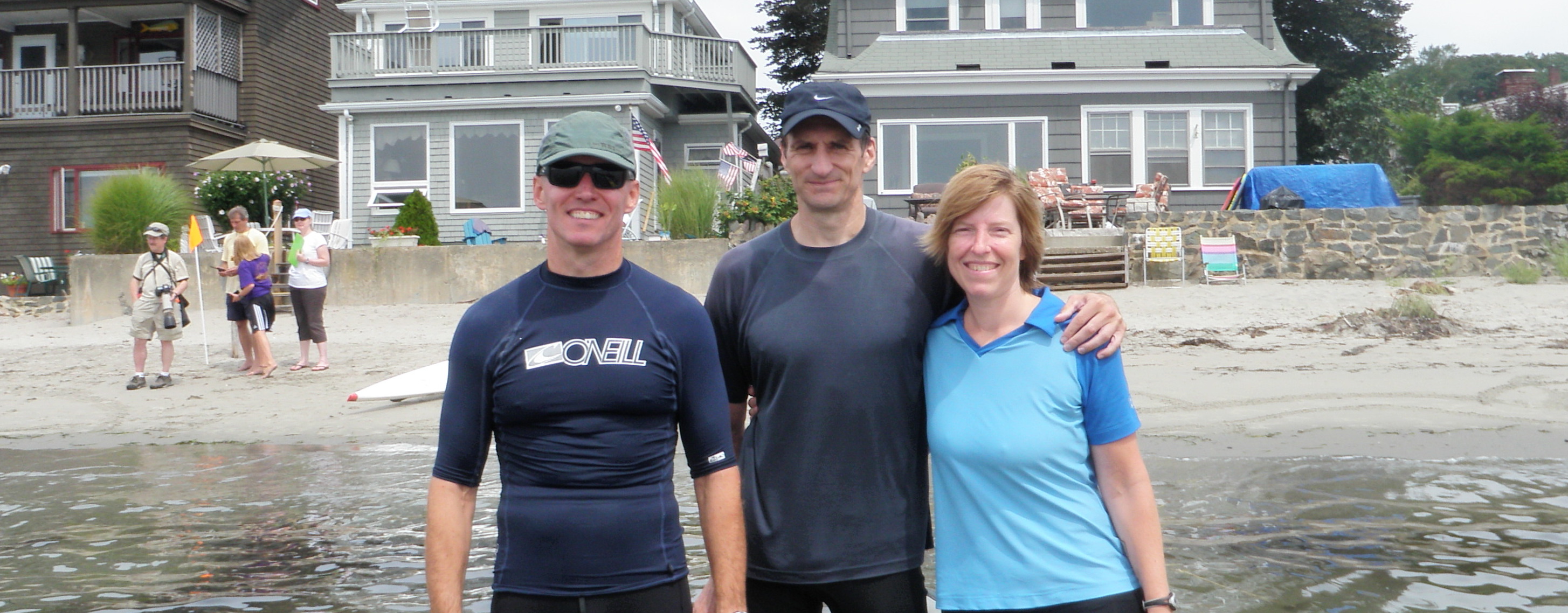
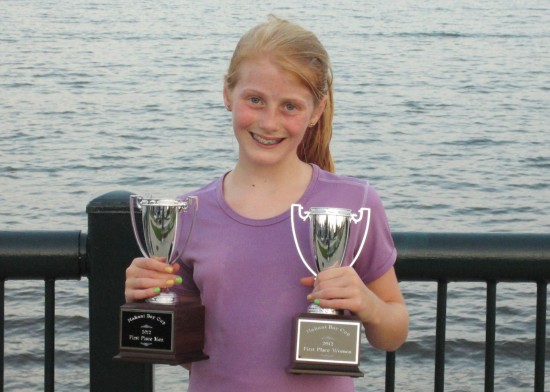
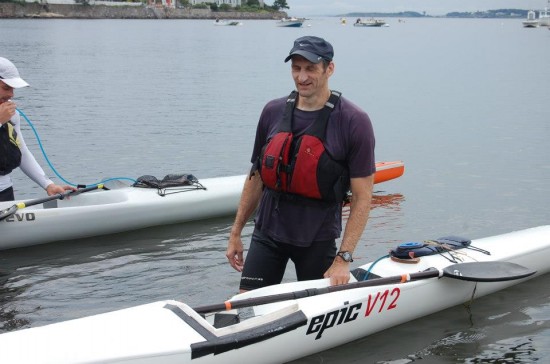
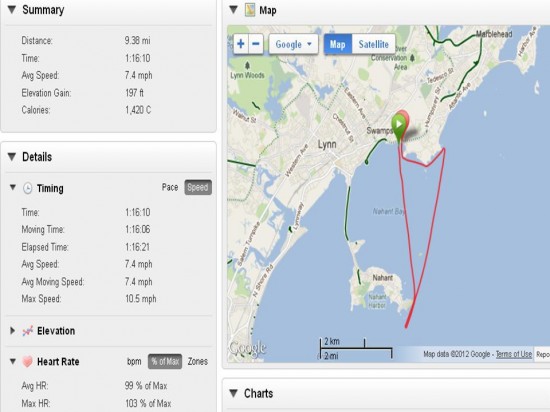
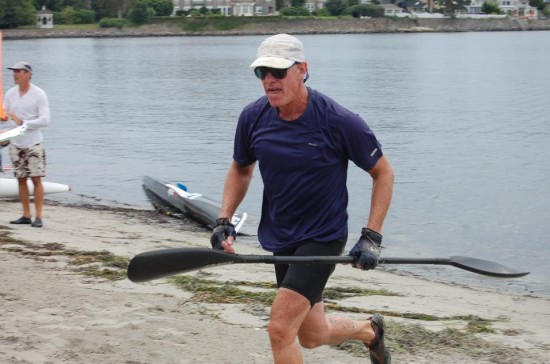
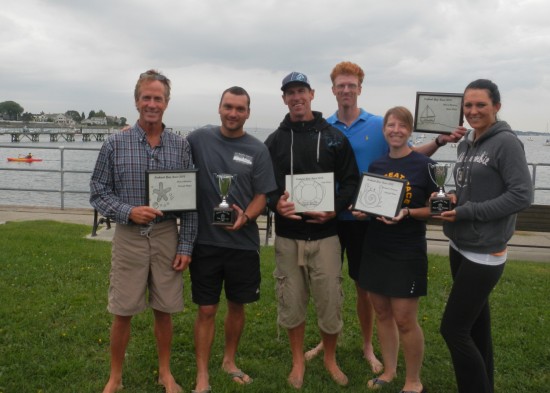
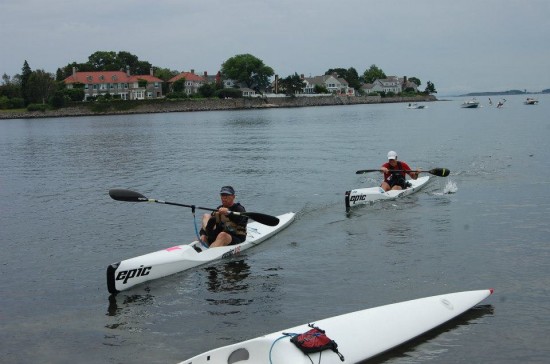
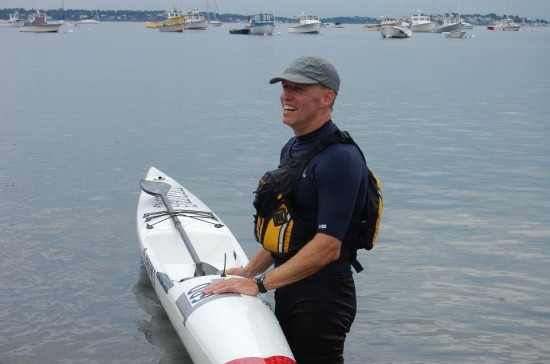
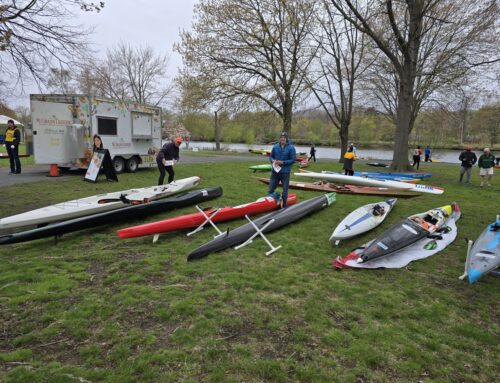
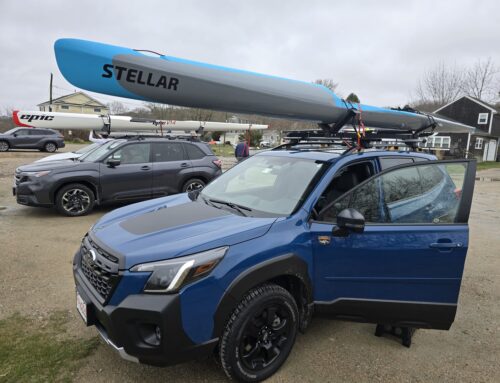
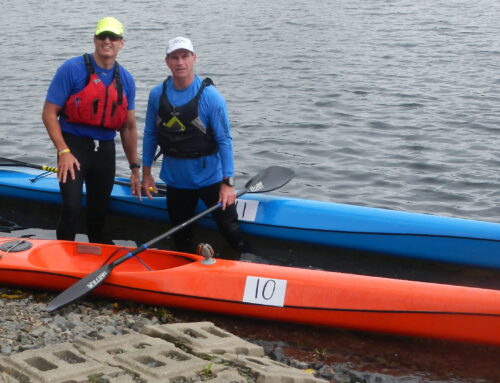
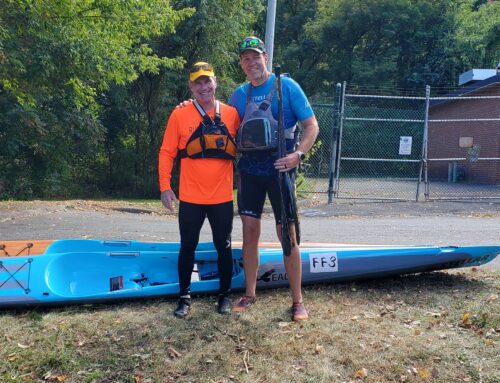
Leave A Comment
You must be logged in to post a comment.